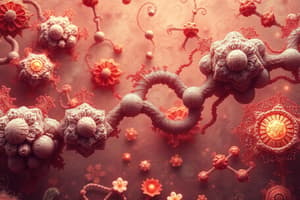Podcast
Questions and Answers
What does Km represent in enzyme kinetics?
What does Km represent in enzyme kinetics?
- The affinity of the enzyme for the substrate (correct)
- The number of substrate molecules converted to product per second
- The maximum rate of an enzymatic reaction
- The concentration of substrate at which the reaction rate is half of Vmax (correct)
Which of the following statements about competitive inhibitors is true?
Which of the following statements about competitive inhibitors is true?
- They increase the Km value without affecting Vmax. (correct)
- They decrease Vmax but do not alter Km.
- They have no effect on the enzyme's affinity for substrate.
- They bind irreversibly to the enzyme.
What do the Tense (T) and Relaxed (R) states of hemoglobin refer to?
What do the Tense (T) and Relaxed (R) states of hemoglobin refer to?
- Variations in the pH of the blood
- Different types of oxygen-binding interactions
- The two forms of heme in myoglobin
- The conformational states that affect oxygen affinity (correct)
What is the Bohr effect?
What is the Bohr effect?
How does 2,3-BPG regulate O2 binding to hemoglobin?
How does 2,3-BPG regulate O2 binding to hemoglobin?
What is the significance of P50 in oxygen binding curves?
What is the significance of P50 in oxygen binding curves?
What mechanism of catalysis involves the stabilization of the transition state?
What mechanism of catalysis involves the stabilization of the transition state?
Which of the following describes the role of ribozymes?
Which of the following describes the role of ribozymes?
Flashcards
Enzyme catalysis
Enzyme catalysis
Enzymes speed up chemical reactions by lowering the activation energy.
Michaelis-Menten constant (Km)
Michaelis-Menten constant (Km)
Km is the substrate concentration at which the reaction rate is half of its maximum velocity.
Competitive inhibitor
Competitive inhibitor
A competitive inhibitor binds to the enzyme's active site, preventing the substrate from binding.
Hemoglobin's Oxygen Binding
Hemoglobin's Oxygen Binding
Signup and view all the flashcards
Cooperativity in Hemoglobin
Cooperativity in Hemoglobin
Signup and view all the flashcards
Bohr effect
Bohr effect
Signup and view all the flashcards
Lineweaver-Burk plot
Lineweaver-Burk plot
Signup and view all the flashcards
Ribozymes
Ribozymes
Signup and view all the flashcards
Study Notes
Enzymes
- Enzymes are biological catalysts
- Substrate binding models exist
- Enzyme rate enhancement calculations exist
- Ribozymes are RNA catalysts
- Reaction coordinate diagrams explain enzymatic reactions
- Different types of catalysis enhance enzyme rate
- Serine proteases are a type of enzyme with specific mechanisms
- 6 major enzyme classes exist
Enzyme Kinetics
- Saturation curves describe enzyme kinetics
- Michaelis-Menten equation explains enzyme kinetics
- Steady-state assumption simplifies enzyme kinetics
- Km value indicates substrate affinity
- Km value relates enzyme and substrate affinities
- kcat represents catalytic rate
- Catalytic efficiency relates to both kcat and Km
- Turnover number quantifies catalytic activity
- Enzyme kinetics plots (Lineweaver-Burk) determine Km and Vmax
- Competitive inhibitors affect Vmax and Km
- Uncompetitive inhibitors affect Vmax and Km
- Noncompetitive inhibitors affect Vmax and Km
- Lineweaver-Burk plots help identify inhibition types
- Enzyme regulation methods exist
Hemoglobin
- Myoglobin and hemoglobin structures differ
- Heme prosthetic groups bind oxygen
- Oxygen saturation values (Y02) measured
- Oxygen binding curves for Hb and Mb exist
- P50 parameter describes oxygen-binding affinity
- External factors (PO2, [O2]) affect oxygen binding
- P50 calculations based on oxygen binding curves
- Allostery describes conformational shifts
- Tense (deoxy) and relaxed (oxy) states in hemoglobin exist
- Cooperativity explains oxygen binding
- Oxygen transport in the body involves hemoglobin
- Allosteric effectors modify oxygen binding
- pH (Bohr effect) impacts oxygen binding
- 2,3-BPG regulates hemoglobin oxygen binding
- Hemoglobin mutations can impact structure and function (conservative vs. nonconservative)
Studying That Suits You
Use AI to generate personalized quizzes and flashcards to suit your learning preferences.




